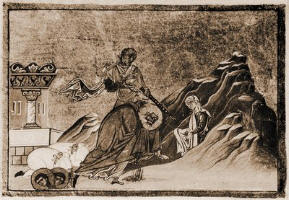
The Works Of Dionysius The Areopagite Volumes 1 & 2
SECTION III
But if any one should blame the descriptions as being incongruous, by saying that it is shameful to attribute shapes so repugnant to the Godlike and most holy Orders, it is enough to reply that the method of Divine revelation is twofold; one, indeed, as is natural, proceeding through likenesses that are similar, and of a sacred character, but the other, through dissimilar forms, fashioning them into entire unlikeness and incongruity. No doubt, the mystical traditions of the revealing Oracles sometimes extol the august Blessedness of the super-essential Godhead, as Word, and Mind, and Essence, manifesting its God-becoming expression and wisdom, both as really being Origin, and true Cause of the origin of things being, and they describe It as light, and call it life. While such sacred descriptions are more reverent, and seem in a certain way to be superior to the material images, they yet, even, thus, in reality fall short of the supremely Divine similitude. For It is above every essence and life. No light, indeed, expresses its character, and every description and mind incomparably fall short of Its similitude.
But at other times its praises are supermundanely sung, by the Oracles themselves, through dissimilar revelations, when they affirm that it is invisible, and infinite and incomprehensible; and when there is signified, not what it is, but what it is not. For this, as I think, is more appropriate to It, since, as the secret and sacerdotal tradition taught, we rightly describe its non-relationship to things created, but we do not know its superessential, and inconceivable, and unutterable indefinability. If, then, the negations respecting things Divine are true, but the affirmations are inharmonious, the revelation as regards things invisible, through dissimilar representations, is more appropriate to the hiddenness of things unutterable. Thus the sacred descriptions of the Oracles honour, and do not expose to shame, the Heavenly Orders, when they make them known by dissimilar pictorial forms, and demonstrate through these their supermundane superiority over all material things. And I do not suppose that any sensible man will gainsay that the incongruous elevate our mind more than the similitudes; for there is a likelihood, with regard to the more sublime representations of heavenly things, that we should be led astray, so as to think that the Heavenly Beings are certain creatures with the appearance of gold, and certain men with the appearance of light, and glittering like lightning, handsome, clothed in bright shining raiment, shedding forth innocuous flame, and so with regard to all the other shapes and appropriate forms, with which the Word of God has depicted the Heavenly Minds.
In order that men might not suffer from this, by thinking they are nothing more exalted than their beautiful appearance, the elevating wisdom of the pious theologians reverently conducts to the incongruous dissimilarities, not permitting our earthly part to rest fixed in the base images, but urging the upward tendency of the soul, and goading it by the unseemliness of the phrases (to see) that it belongs neither to lawful nor seeming truth, even for the most earthly conceptions, that the most heavenly and Divine visions are actually like things so base. Further also this must particularly be borne in mind, that not even one of the things existing is altogether deprived of participation in the beautiful, since, as is evident and the truth of the Oracles affirms, all things are very beautiful.

 Keep Site Running
Keep Site Running